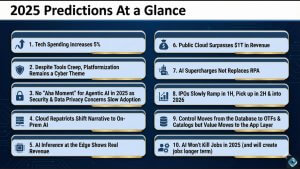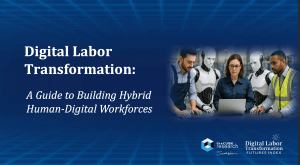Our new survey data and real-world lessons from Doozer.ai, among others, show that the world of AI is at a major turning point, defined not by task automation but by higher-ROI reasoning and decision intelligence. After years of fascination with generative AI, companies are now focusing on transforming those core abilities into impactful business results. They envision AI agents, acting as digital coworkers, that can assist humans in thinking more efficiently, solving problems, and making smarter decisions.
These use cases represent the next phase in enterprise AI: shifting from content creation and task automation to decision intelligence within agentic workflows. As organizations cross this threshold, their ambitions are expanding. Leaders are no longer satisfied with marginal productivity gains; they are reimagining what it means to be an “intelligent enterprise.” The goal is no longer to automate known workflows, but rather to augment human reasoning itself. The aspiration is to create a new class of digital knowledge workers capable of understanding goals, evaluating trade-offs, and helping their human counterparts make confident, data-driven, and explainable decisions.
However, the challenges are equally real. Fragmented strategies, weak governance, and shaky trust continue to limit ROI to isolated pockets of automation. Many organizations are discovering that scaling AI is not just a technical problem; it’s an operational and cultural one.
This research brief explores the factors behind that gap and the practical path forward. It combines data from the Agentic AI Futures Index, which includes 625 pre-qualified business & tech AI professionals answering 61 questions, with real-world insights from Doozer AI, a company leading in deploying digital coworkers that produce measurable results.
Together, they offer one of the clearest perspectives yet on how organizations progress along the maturity curve, from experimentation to scaling and from statistical correlation to trusted reasoning.
This brief explores what that number really means, namely the:
- Move beyond generative AI & LLMs
- Surge of investment in AI reasoning
- Rise of digital knowledge workers
- New currency of ROI
- Road ahead: what to do next
Overall, these findings show both strength and vulnerability. The opportunity is evident, but the execution gap is apparent. Identifying where aspiration, strategy, and reality differ is essential. The next sections examine what the Index and real-world experiences reveal about how companies can close that gap, and turn the potential of generative AI into the foundation for true Agentic AI ROI.
Watch the Podcast
In this episode of Next Frontiers of AI, host Scott Hebner is joined by Paul Chada, CEO of Doozer AI, to explore one of the most urgent questions in enterprise AI: What is the real state of agentic AI ROI, and where is it headed? As companies shift from foundational Generative AI to the ”golden age of AI Agents”, the stakes are rising. AI agents are no longer expected to create content or automate repetitive tasks; they are now actively involved in knowledge work and decision-making processes. In this discussion, we share real-world lessons from AI agent deployments and present new findings from the Agentic AI Futures Index survey to illustrate how adoption is progressing, where plans are accelerating, and what the journey toward decision intelligence entails.
The Topline Storyline
The latest results from the Agentic AI Futures Index indicate a market that’s full of ambition, yet still struggles to translate early promise into solid business results. Investment and awareness are increasing, but many organizations are stuck between vision and real value.
This research brief explores one of five index surveys conducted by theCUBE Research, which measures this shift with hard data, not hype. Drawing from 625 pre-qualified AI business and technology leaders across 13 industries and 61 questions, the indices score organizations on a 0–5 maturity scale. The 2025 average is 3.1 out of 5, indicating steady progress beyond experimentation but highlighting a gap in achieving scalable, trusted, and agentic AI programs.
We found a market quickly transitioning beyond generative AI to agentic AI, and thus, a shift from automation to decisions. At the top level, 61% of companies report that they are either deploying or planning to deploy AI agents within the next 18 months, a notable figure given the market’s relative newness. These early adopters observe a clear shift happening: from basic task automation to knowledge work and decision-making empowered by AI reasoning.
The survey data tells a story of strong investment momentum, growing use-case maturity, and an unmistakable trust gap that could limit ROI if not addressed directly. Key findings include:
- Investment (3.7) – A Leap Toward Decision Intelligence: Enterprises are not holding back on budgets. Nearly three-quarters (73%) report significant or strategic investments in AI reasoning and decision intelligence capabilities—areas designed to move beyond “chat” and into judgment-based work. This signals the beginning of a structural pivot: from automation as productivity to decision intelligence as strategic advantage.
- Use Cases (3.1) – The Rise of Knowledge Work: Enterprise leaders, especially those with the most experience in AI, envision a shift from AI that makes predictions to AI that can make judgment-based decisions. Many organizations remain in the pilot or proof-of-concept stage, utilizing agents for analysis, reporting, and process optimization, but have not yet entrusted them with goal-driven decisions.
- Trust (2.4) – The Currency of ROI: Trust remains the lowest-scoring dimension in the index—and the biggest barrier to realizing value. Only about half of AI professionals say they have high confidence in agents’ ability to make decisions, even when they’re confident in their planning or analytical abilities.
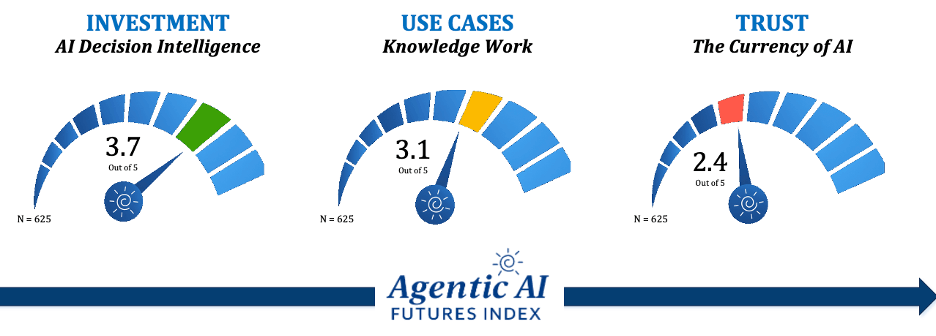
Taken in aggregate, the data reveals a clear and accelerating pattern: investment is outpacing application, and both are outpacing trust. Most enterprises now see AI agents as essential partners in future knowledge work, yet many are still learning how to align strategy, governance, and workforce readiness to make that vision operational. The findings highlight three defining shifts reshaping the landscape:
- The vast majority envision a higher ROI than GenAI can deliver alone.
- The shift beyond task automation to AI-driven decision-making is accelerating.
- Trust has emerged as the true currency linking investment to impact.
The data support this point. When examining decision intelligence, investment exceeds readiness. Enterprises rate their investment maturity at 3.7, indicating aggressive spending on reasoning, planning, and orchestration capabilities. However, use-case maturity lags at 3.1, as organizations struggle with deployment complexity and workforce alignment. Most notably, trust scores only 2.4, the lowest across all measured dimensions.
Paul Chada, CEO of Doozer AI, sees the same pattern playing out in the field.
“A lot of executives are saying they’re deploying agents because the board is asking, ‘What are you doing with AI?’ But the real work—the part that drives ROI—is getting the agents to be reliable and accepted by the people who use them,”he said. “If the agent isn’t dependable, it becomes a shiny object that’s quickly cast aside.”
The Gateway to Something Bigger
A generation ago, the browser marked the beginning of the internet era. Industry discussions focused on who would “control” what many called “the gateway to the web.” At that time, choosing which browser to use was seen as a strategic, business-critical decision. But as history revealed, the browser itself was only the starting point. The transformative value of the internet was built on that gateway through an ecosystem of advanced technologies, applications, and business models built around the browser, which in turn turned connectivity into productivity, commerce, and insight.
Today, a parallel story is unfolding in the realm of AI. Generative AI and large language models (LLMs) are the new “browsers”, indispensable entry points, yet only the foundation for something far greater. The “Gen AI wars” of 2023–2025, pitting OpenAI, Google, Anthropic, Meta, and DeepSeek against one another, echo that same early-internet race for dominance. But as Scott Hebner noted in the Next Frontiers of AI podcast,
“Generative AI is just a gateway to the world of AI. The real ROI comes from what we build on top of it, just like the browsers in the internet age, where they were extended from connectivity and access, to transactional commerce and advanced insights.”
That “next layer” is Agentic AI: systems that go beyond predicting the next word or automating a known process. Built upon the foundation of GenAI and LLMs, Agentic AI promises to introduce reasoning, judgment, and decision-making into digital workflows. Just as the browser transformed from a simple tool for accessing information into a platform for creating enterprise value like e-commerce, the new wave of AI agents is evolving to represent the next level of decision intelligence. These agents are not just tools; they’re collaborative digital coworkers that assist humans in thinking, acting, and making better decisions.

Over the past three years, LLMs have achieved remarkable fluency and reach, laying the groundwork for enterprise adoption. Yet their limitations are becoming clear: they can predict but not judge, correlate but not explain, and automate but not reason. As Paul Chada, CEO of Doozer AI, observed,
“A prediction is not a decision. You can only trust an agent when it shows that it understands the goal, the context, and the consequences of its actions.”
Enterprises are now recognizing that LLMs alone “run out of gas” when it comes to high-value use cases and the pursuit of sustained, transformative ROI. Most models still operate as statistical engines, powerful but limited to what can be accomplished by statistical correlations and probabilities. This explains why, despite 70% of companies experimenting with LLMs, fewer than one in five achieve measurable ROI at scale.
The missing key is actual reasoning, the ability to develop domain-specific knowledge, understand relationships and meaning, connect cause and effect, weigh options, and justify outcomes. Companies that recognize this early will lead in AI innovation and ROI. The gateway matters less than what you build through it.
This is why 2025 marks a turning point. The market is pivoting from building bigger models to building more innovative model ecosystems. Enterprises are investing in decision intelligence, an emerging layer that integrates LLMs with reasoning frameworks, knowledge graphs, memory architectures, and causal models. These capabilities allow AI agents not only to execute tasks but also to explain why they recommend one action over another, and to continuously learn from results.
In this sense, Agentic AI represents the layer of enterprise AI, where productivity, trust, and reasoning converge. As Scott Hebner framed it,
“Just as the browser became the portal to the digital economy, Gen AI is the portal to the reasoning economy, but in both cases, you need to populate the portal with new technologies that deliver new value.”
The Shift to Decision Intelligence
The enterprise AI market is going through a major shift—from automating basic tasks to enabling intelligent decision-making. What began as a competition to use generative AI for increasing productivity and content creation has evolved into a strategic pursuit of decision intelligence, where AI agents become active contributors to knowledge work, reasoning through complex scenarios alongside humans.
The Agentic AI Futures Index clearly indicates a clear ROI-driven turning point, with 73% of companies planning to make strategic, significant investments in AI reasoning and decision intelligence over the next 18 months. Among these, 37% report considerable funding across multiple programs, while another 36% say AI reasoning has become a key part of their enterprise strategy.
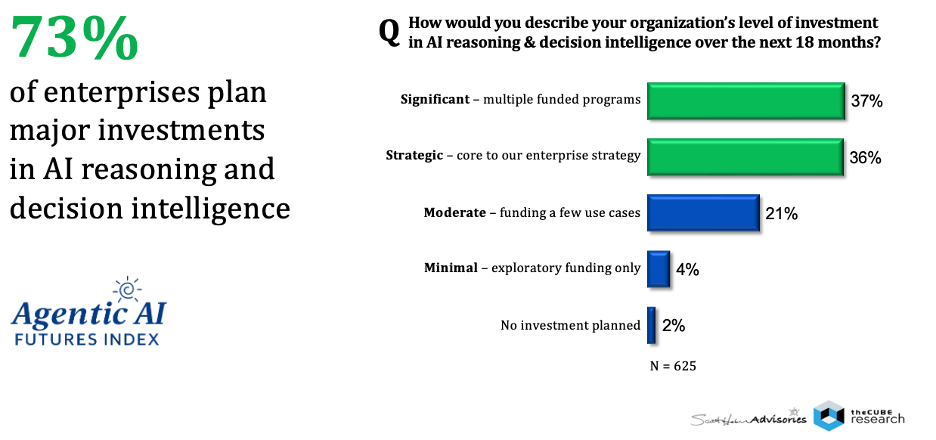
This new wave of investment indicates a broader maturing of AI use cases. The initial phase of enterprise AI focused on automation and productivity, utilizing technology to complete repetitive tasks more efficiently, generate content, or compile information. However, as those improvements plateau, business leaders are targeting a higher goal: augmenting human judgment and supporting data-driven, explainable decision-making at scale.
As Paul Chada, CEO of Doozer AI, explained in the podcast,
“Every company is now asking how to build reasoning into their workflows. It’s not about automating the easy stuff anymore; it’s about giving your teams judgment and decision support at scale.”
To achieve this, organizations are investing not only in larger models but also in smarter model ecosystems that build upon the foundation of generative AI. Decision-intelligent agents require a fundamentally different architecture, one that extends LLMs with:
- Semantic understanding of the business domain, so agents grasp context, meaning, and intent behind data and processes, anchored in dynamic knowledge graphs.
- Judgment frameworks allow them to evaluate trade-offs, interpret ambiguity, and simulate alternative courses by modeling the consequences of various decisions.
- Causal reasoning enables them to understand why certain decisions lead to specific outcomes and what influences those outcomes (cause & effect).
- Collaborative learning loops, so agents can interact naturally with their human counterparts, testing assumptions, presenting evidence, and converging a mutual decision.
These capabilities mark a major shift from rule-based automation to reasoning-based enhancement. Instead of just following steps in a workflow, next-generation AI agents will help determine which steps to take and why. They will provide insights, suggest actions, and clearly explain their logic—acting less as digital assistants and more as digital colleagues that can improve decision-making in enterprises. This increase in decision-intelligence investment indicates that the enterprise AI narrative is shifting from focusing on productivity improvements, measured in hours saved, to emphasizing strategic gains, measured in better outcomes.
The message: Better problem-solving and remediation decisions will also trump automation in scaling ROI within enterprise settings. Money talks.
The Rise of Digital Knowledge Workers
If the first phase of enterprise AI was about automation, the next is clearly about augmentation—enhancing human intelligence in knowledge work. The Agentic AI Futures Index shows that this shift is speeding up: 62% of companies now see their AI agents as a key part of decision-making. This marks a big move from the automation-focused past toward a new era of AI-driven decision intelligence.
Traditional automation remains important (67%) as leaders still see value in streamlining routine or repetitive processes—but the frontier is clearly moving upward. Knowledge work—defined as work that requires domain-specific judgment to make business-critical decisions—is becoming the main focus for AI investment. Unlike procedural tasks like provisioning systems, updating records, or booking travel, knowledge work involves reasoning about what the right action or decision should be and being able to justify it. These are the kinds of decisions that influence business results, shape customer experiences, and guide strategic direction.
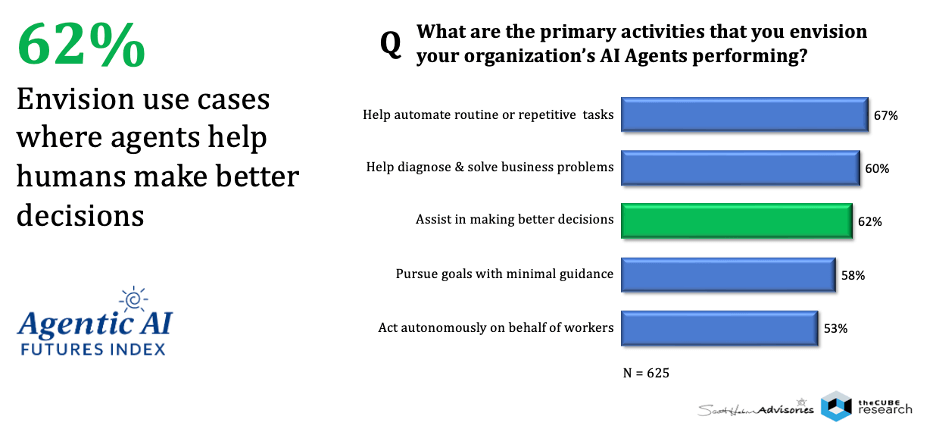
In this context, the role of AI agents is evolving from automating the “known” to assisting in the unknown, helping humans reason through ambiguity, evaluate trade-offs, and act with confidence.
As Paul Chada, CEO of Doozer AI, explained, “There’s a big difference between using AI to do work faster and using it to help people think better. The best deployments we’re seeing are the ones where agents help humans see what they might have missed—and then make the right call with confidence.”
This evolution reflects the broader trend identified in the Digital Labor Transformation Index, where over 90% of leaders agreed that digital labor is inevitable. Enterprises no longer question if humans and AI agents will collaborate, but how fast and how deeply that collaboration will extend into knowledge-based decision-making. The rise of these use cases underscores that agentic AI isn’t just about efficiency—it’s about reshaping how expertise is applied and scaled across the enterprise.
To fulfill this vision, organizations are investing in agents that can go beyond pattern recognition to understand meaning, context, and consequence. Decision-intelligent agents must have at least the following five attributes:
- Understand semantic content
- Apply reasoning frameworks
- Make judgments, not just predictions
- Evaluate consequences and trade-offs
- Collaborate with humans (“what-if”)
These capabilities are giving rise to a new class of digital knowledge workers—agents that do not replace human reasoning but enhance it. They can analyze large-scale scenarios, consider multiple viewpoints simultaneously, and provide evidence-based recommendations that humans can understand and trust.
Ultimately, the shift toward decision-focused knowledge work marks the next frontier of digital labor. As enterprises adopt agentic AI, they’re moving from “doing things faster” to “making better decisions,” unlocking higher-value outcomes through collaboration between human judgment and machine reasoning.
The New Currency of ROI
With enterprise AI, we see a quickly changing market that is full of ambition and moving rapidly. It’s full of experimentation but still faces challenges in turning early potential into long-term enterprise performance and ROI. Investments and awareness are increasing, but many organizations remain caught between vision and actual value. As enterprises leverage the “gateway to AI” (foundational Gen AI and LLMs) to pursue higher, more transformative AI use cases, a deeper truth is emerging: trust has become the key obstacle to achieving ROI. As Scott Hebner stated during the Next Frontiers of AI podcast,
“Trust is emerging as the currency of innovation. No trust, no ROI.”
While LLMs have democratized access to AI much like browsers democratized access to the internet, enterprises are realizing that adoption will stall without confidence in accuracy, reliability, and reasoning. People only use what they trust, and in business-critical contexts where AI agents influence or make decisions, that trust must be earned through transparency and performance, not hype.
Importantly, the new survey data show that trust in AI extends far beyond accuracy. It is built through explainability, human collaboration, and understanding the exact sequence of events that lead to outcomes. When humans can see how and why an AI arrived at its conclusion, they are more likely to trust it. When the system can explain its reasoning, respond to challenges, and make evidence-based adjustments, adoption naturally follows.
The Agentic AI Futures Index clearly highlights a trust gap: only 49% of enterprise leaders are highly confident that AI agents can make accurate and trustworthy decisions. Furthermore, the low trust levels are consistent across planning and problem-solving (50%), explainability (47%), and autonomous action (44%), all elements of the decision-making process. The data shows that organizations trust AI to carry out tasks, but not yet to make decisions. As Paul Chadaemphasized, successful deployments depend on agents performing reliably under real-world conditions, with the dependability that encourages users to adopt and expand
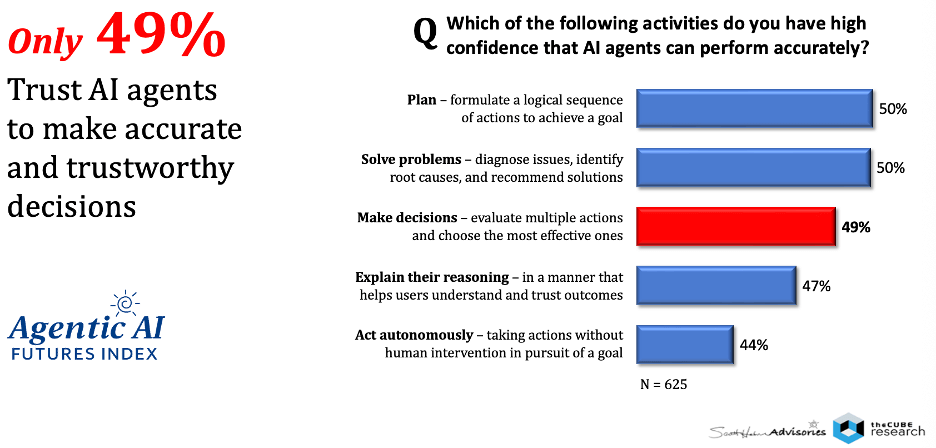
Trust, therefore, is the key difference between statistical prediction and judgment-based reasoning. Generative AI finds patterns in data; however, AI reasoning must also understand the consequences of decisions, and thus cause and effect. That shift — from correlation to reasoning — is what will deliver true decision intelligence, and ultimately the ROI goals of Agentic AI investments.
Our research and field observations identify several important traits that make AI trustworthy.
- Accuracy and Consistency
- Conversatinal Explainability
- Human Collaboration:
- Semantical Awareness
- Root Cause Detection
- Consequence Evaluation
As Chada explained from Doozer’s real-world deployments, trust develops through parallel operations, where agents run alongside human teams until confidence in decision quality is established.
“Organizations are just wanting to run it in parallel right now. As they see it make the correct decision repeatedly, trust builds naturally, and that’s when autonomy becomes acceptable.”
Chada also sees an elevation in importance among his customers:
“A lot of executives are saying they’re deploying agents because the board is asking, ‘What are you doing with AI?’ But the real work —the part that drives ROI —is getting the agents to be reliable and accepted by the people who use them. If the agent isn’t dependable, it becomes a shiny object that’s quickly cast aside.”
This “trust drag” isn’t just technical, it’s cultural. Organizations are discovering that deploying agents is not like installing software. It’s more like hiring employees. Workers must believe their digital counterparts will behave consistently, explain their reasoning, and improve over time. Without trust, adoption stalls, and ROI vanishes.
The future of AI, therefore, won’t be defined by which model produces the most words or the fastest predictions, but by which systems can reason, explain, and be trusted to make decisions that matter. Trust isn’t just a feature; it’s the foundation of the intelligent enterprise. As Hebner concluded,
“If you don’t trust a human coworker, you’re not going to work with them very well. The same is true for digital coworkers. Until people trust them to make sound decisions, agentic AI will remain a parallel experiment rather than a full participant in the workforce.”
The Road Ahead: What to do Next
The Agentic AI Futures Index makes one reality clear: investment in AI reasoning and decision intelligence is surging, but operational trust and end-user adoption remain the gating factors in ramping ROI within the enterprise. The next two years will define the winners,those who build trusted AI ecosystems that scale decision intelligence, and the laggards, who remain trapped in experimentation. And if you fall too far behind, you may never be able to catch up.
To close this gap and realize the true ROI of Agentic AI, leaders must reframe their efforts from automating tasks to empowering decisions. Our conclusions from the research and real-world use cases lead us to the following recommendations:
- Separate but connect strategies: A technology roadmap for AI reasoning, agents, and orchestration differs from an operating model for workforce trust, governance, and role evolution. Both should be developed concurrently and linked through shared metrics, with the aim not just of increasing productivity but of making decisions that are better and explainable.
- Climb the value curve quickly: Automation is the foundation. GenAI and LLMs are the key “gateway to AI.” The real value comes when digital coworkers help humans make better judgments in complex, high-stakes decisions. Companies that lead in AI decision intelligence will set the pace for the next decade. With these technologies emerging and increasingly proven in real-world use cases, it’s time to start experimenting with moving from testing to deployment.
- Double down on trust: Confidence in AI automation is high, but trust in AI reasoning and autonomy remains fragile. Build cultural and operational trust through explainability, transparency, and shared problem-solving. Trust is not optional; it’s the currency that turns innovation into ROI.
- Endlessly communicate: Aspirations often outpace execution, and this gap can weaken confidence. Leaders must communicate progress transparently, involve employees early, and emphasize that AI is a partner, not a substitute. Shared understanding speeds up adoption. Also, build an ecosystem of experts and partners to help share risk and rewards throughout this journey.
The research referenced in this research brief forms a part of the broader 2025 Agentic AI Futures Index, a five-part benchmark that measures enterprise readiness across:
- Digital Labor Transformation
- Agentic AI Technology
- Trust & Governance
- Reasoning & Decision Intelligence
- Causal AI Innovation
Together, these indices offer one of the first comprehensive roadmaps for enterprise leadership in the age of agentic AI and decision intelligence.
If you’d like to explore the complete data and analysis in more depth, please reach out here or connect with me on LinkedIn.


